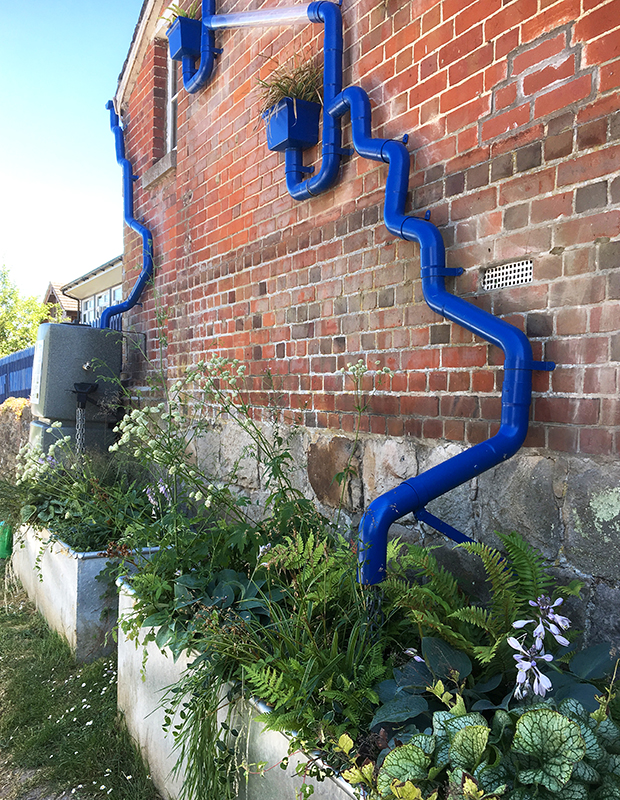The Citizen Gardener: Bringing in the rain

Every year I draw a pencil line around and date the many damp patches on my walls. The walls now look like a contour map of a group of atolls in an ocean as the watery spots grow over the years. Plumbers and builders tell me that water just finds its own way from a leak, not in an obvious or direct line. We have never found the source.
So, I am often vexed by water in the wrong place, particularly as a gardener. The lack of it, too, worries me in general.
Last year we had about three months without any rain. Then downpours. This is how it’s going to be. Meteorologists call them rain events – heavy showers which drop more than 50mm in one burst.
According to the Met Office the intensity and frequency of these events will increase as the temperature rises because warm air holds on to more water which it then releases in greater volume.
These downpours are one of the reasons we are getting more regular and greater amounts of foul water in our rivers. There were 403,171 storm overflows recorded in 2020. Each time this happens raw sewage ends up in rivers. And raw sewage in rivers is not good for them – or us.
It happens because water companies are allowed to release sewage into rivers in exceptional circumstances – when the system is overloaded. Our infrastructure just isn’t designed to cope with the increased volume of water it is now dealing with through population increase, climate change and our own wasteful habits. So these exceptional circumstances are becoming commonplace.
In the Rivers Trust’s ‘State of Our Rivers’ report this year they say that only 14 per cent of our rivers are in good ecological health. They assessed the River Lea as ‘bad’.
Almost everything we do on the land and in our homes impacts rivers (and ultimately the sea) – from cleaning our cars on the street and washing pollution and detergent down the drain, paving over our gardens, eating food grown with fertilisers, pouring oil down sinks or baby wipes down toilets. The way we treat our waste has a huge impact on the health of our water systems and the environment in general.
We’ve built on places that used to absorb water. Front gardens have been turned into hard standing which means that water that would have slowly gone into the ground, now goes straight down the drain into the mains and then overloads the system.

The way rivers and land are managed also contributes to flooding – building has been allowed on flood plains; trees, which take up water, are removed upstream; rivers have been dredged and canalised in urban areas so don’t flood naturally which means water is forced downstream – often where dense habitation is – to flood.
The weight of these calamities can feel enormous so to be able to do something is a great relief.
But what?
One thing is to understand where our waste water goes. And then we can reduce what goes down the open drains.
I went on an excellent online course recently run by Raingarden UK – a collaboration between garden designer, Wendy Allen and Charlotte Hitchmough of Action for the River Kennet (ARK). The focus was on how to reduce the amount of rainwater going down the drains through making gardens adapted to soak up the water.
I was vaguely aware of how a house should be plumbed: rain water from gutters goes into an open drain. Waste from the loo, washing machine, kitchen sink and other ‘grey’ water goes a separate route to a sewage works. But I didn’t know that any water that goes into a surface water drain – the ones you see with a grid in the street or under your gutter – then goes directly into a river whether the water is clean or polluted. I also learned that many properties are plumbed badly so that both systems (rain water and house water) are joined into one pipe or both simply go down the same open drain.
You can check whether you are plumbed properly with the help of connectright.org.uk. I’ve just looked at mine and it seems like water from the kitchen and washing machine go straight down the open drain – so I need to fix that! Only rainwater should be going down the open drain.
But a simple way each of us can help is to stop rainwater going down the drain so that less overflows. This means diverting rainwater from gutters into a planter or, more extensively, into a whole rain garden.
A rain planter is simply a planter (often made from an old cattle trough) with layers of sand, gravel, soil, plants and a pipe which takes rainwater from your downpipe (usually via a water butt) into the planter. It will, of course, water the plants you put in there, but crucially slow down and absorb excess water.
Wendy’s photo of her planters at a school (the pipes don’t need to be as elaborate), shows how it works off a big building but you could put one next to a shed, bin or bike shelter. Perhaps we could put them next to every bus shelter in Hackney.
The benefits of rain planters, according to Wendy, are that they help prevent flash flooding, improve the quality of water entering rivers, reduce sewer overload, improve urban biodiversity, are simple to create and you don’t need planning permission unless the building is listed or in a conservation area.
If you want to go on Wendy and Rain Garden UK’s next course the dates are on their Facebook page (facebook.com/raingardenuk). It’s free, funded by Wiltshire Wildlife Trust and Thames Water.
As Wendy says, ‘Rain planters can be installed in the smallest of spaces. These small scale, achievable features add up to big change, and should be in every garden and community space.’
Every small act may seem like a drop in the ocean but if everyone does something small we can really make a difference.
Kate is an award-winning community gardener. She was chosen to be the UK’s first ever postcode gardener in E5 as part of Friends of the Earth’s 10xGreener project. For more information, head to cordwainersgrow.org.uk and friendsoftheearth.uk.
